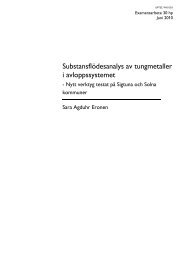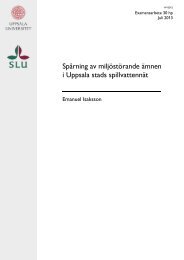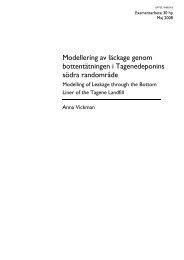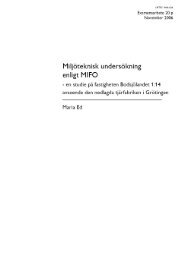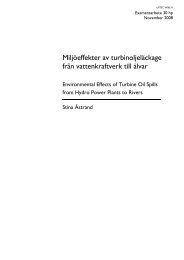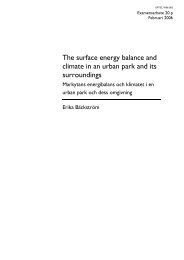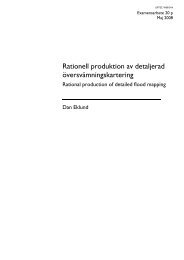Nutrient Transport Modelling in the Daugava River Basin - DiVA Portal
Nutrient Transport Modelling in the Daugava River Basin - DiVA Portal
Nutrient Transport Modelling in the Daugava River Basin - DiVA Portal
You also want an ePaper? Increase the reach of your titles
YUMPU automatically turns print PDFs into web optimized ePapers that Google loves.
a) Streamflow, calibration periodb) Streamflow, validation periodReportedcm/year40353025201510505000019931994199519961997c) Nitrogen load, calibration period19981999cm/year35302520151050600001980198119821983198419851986198719881989d) Nitrogen load, validation periodModelled4000050000ton/year30000200001000020000199319941995199619971998e) Phosphorus load, calibration period1999ton/year40000300002000010000200001980198119821983198419851986198719881989f) Phosphorus load, validation period15001500ton/year1000500ton/year10005000019931994199519961997199819991980198119821983198419851986198719881989Figure 7. Reported and modelled values of yearly means of streamflow,nitrogen loads and phosphorus loads from <strong>the</strong> <strong>Daugava</strong> <strong>River</strong> for <strong>the</strong> calibration period(19932000) and <strong>the</strong> validation period (19801990).Table 2 shows a statistical summary of <strong>the</strong> comparison of observed and predictedvalues. Generally, <strong>the</strong> prediction of yearly values is a lot better than <strong>the</strong> prediction ofmonthly values. Regressions l<strong>in</strong>es were made between reported and modelled values.The R 2 value of <strong>the</strong> regression of modelled and reported yearly nitrogen loads is 0.78and <strong>the</strong> correspond<strong>in</strong>g slope of regression is 1.17. The R 2 value for yearly phosphorusloads is 0.5, but s<strong>in</strong>ce <strong>the</strong> regression slope is only 0.14 <strong>the</strong> ability of <strong>the</strong> model to predictphosphorus loads must be considered to be very low. The regression slope for monthlymeans is generally much lower than for yearly means. This is due to <strong>the</strong> fact that <strong>the</strong>model underestimates peak flows. For yearly values <strong>the</strong> impact of peak flows is not sosignificant, which is why <strong>the</strong> regression slope for yearly means is higher than formonthly means. Plots of <strong>the</strong> regressions are found <strong>in</strong> Appendix F.16



